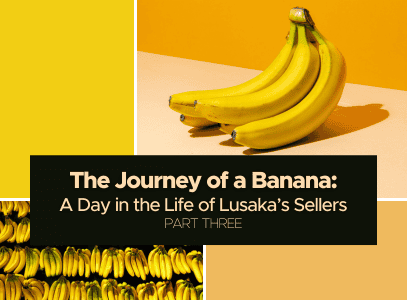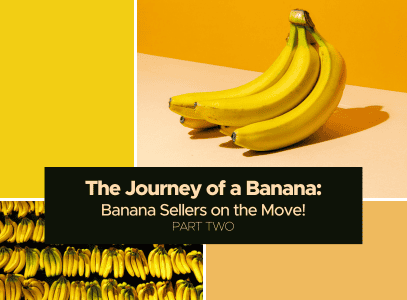Introduction:
Ripening Questions
There is something about buying fruits and vegetables straight from a street stand. Whenever I travel, I enjoy buying food from street shops while quickly chatting with the owner. I guess it makes me feel a bit closer to the place I am visiting… And so, when I stayed in Lusaka for my CCI internship in the summer of 2023, I instantly spotted the man selling bananas from his wheelbarrow on the street of my Airbnb. Every morning, as I walked to work, I would stop by his selling spot to buy a few bananas. And the more I wandered around Lusaka, the more banana sellers I found. I saw them in marketplaces, at crossroads, in front of supermarkets and hospitals. In Lusaka, I could buy bananas when I walked, drove in a taxi, even when I took a bus.
I was happy about the abundance of bananas around the city. Why? Well, I love eating bananas. However, my joy was coupled with curiosity – the urban researcher within me started asking questions.
How do all these sellers get to their posts each morning?
Are their homes nearby, or do they travel from afar?
And where do the bananas come from?
Going Bananas:
The Summer Research
During my stay in Lusaka, I was on a mission to understand the mobility patterns of banana sellers. This yellow fruit became my constant companion, from multiple ‘banana stops’ during taxi rides to buying bananas on the Walking the Unwalkable walk. Soon, my obsession turned into a joke at the CCI office. My colleagues, who quickly got used to snacking on bananas all day long, concluded that I had ‘gone bananas.’
I interviewed over twenty banana sellers in three different parts of Lusaka. I also traced wholesale locations and interviewed supermarket staff and coffee shop owners. All these encounters helped me paint a vivid picture of the ‘Journey of a Banana’ within Lusaka.
The Juicy Streets:
The World of Informal Street (Fruit) Vendors in Africa
Informal street vendors across many African cities display anything and everything, from fresh fruits and vegetables to clothes and electronics. Their very presence, although seemingly ordinary, represents resilience and entrepreneurial spirit.
Take how many challenges both women and men working as street vendors have to overcome every day. Some are practical – like getting around the city with their goods and negotiating with suppliers and customers (if you ever haggled over a price at a street stand, you know it’s tough!), and some are legal – vendors often face threats from local authorities1, 2, 3 or lack access to credit. Street sellers cannot just set up a stand wherever it’s closest or most convenient but have to consider aspects like:
- market demand (where will they sell the most?),
- market unpredictability (markets fluctuate and change),
- competition (can they find places where the market hasn’t been saturated?)
- as well as local regulations (sellers cannot afford to operate on streets that require formalization costs such as licenses or taxes).
The organization of street sellers is largely informal, with little to no formal structures or protection. When I first started asking questions around Lusaka, I went online and searched for signs of coordination among vendors. I only managed to find one Facebook group. It aimed to motivate its over 300 members by posting mottos such as ‘BE SMART WORK SMART AND MAKE SMARTER CASH’). Despite this lack of coordination, there seems to be an unspoken code of conduct, a shared understanding of the ‘rules of the game’. Almost every seller I talked to told me about ‘their spot’ or that they ‘don’t have a spot and therefore walk around the city’ as if some people had an inherent right to sell from specific spots. With a lack of mixed-use development and most of the formal selling situated in malls, sellers have to operate in a delicate balance, competing for customers while also supporting each other in times of need.
As I mentioned above, access to markets is a critical aspect of vendors’ operations. Some studies suggested that street vendors choose their location based on closeness to their homes. But street sellers might need to travel greater distances in sprawling cities like Lusaka with relatively low density to find a viable selling point. There are more complications for fruit sellers specifically: they need to regularly visit their wholesale locations (multiple times per week) or deal with spoilage of produce. This adds up to a non-trivial system fruit vendors need to navigate! Imagine moving to Lusaka from a rural part of Zambia (many street sellers have migrated to Lusaka from the countryside) and wanting to set up a fruit street stand. If you want to succeed, you need to gather enough money to start operating, build social networks, and be able to rapidly adapt to the ever-changing conditions.
To sum up, the existing literature tells us about the mobility and organization of street vendors in general (including research on Lusaka) but doesn’t cover the topic of banana vendors in urban areas specifically. Therefore, by following the ‘Journey of a Banana’, I hope to learn more about mobility patterns, rituals, and challenges of banana sellers in Lusaka.
Sneak Peek:
What’s Up Next
My upcoming blog post series – ‘The Journey of a Banana’, illustrates how bananas make their way around the city. In the second blog post, I will bring the stories of individual sellers and explain the three clusters within Lusaka I chose for collecting the data. In the final blog post, I will reflect on the research and share key findings.
There is more to the banana stands of Lusaka than meets the eye. So, get your favorite banana snack ready and join me on my way to understanding the life of banana vendors in urban areas. Let’s go bananas in Lusaka!








